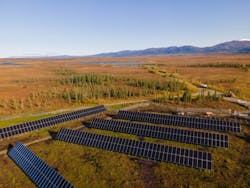A microgrid with energy storage takes on a whole new meaning when you are truly ‘off the grid’ in a place where temperatures can drop to 40 below zero.
Such is the case in Shungnak, Alaska, a 9.6 square mile community of about 300 people that live in the Northwest Arctic Borough above the Arctic Circle.
Details about the community’s new microgrid were unveiled today by California-based Blue Planet Energy, which provided its lithium iron phosphate batteries for the project.
Shungnak faces daunting energy challenges because of its remoteness. Before the microgrid was installed, the community relied on a diesel power plant, which is checked three times a day but is not staffed full-time.
“People have to take charge of making sure the fuel is in the diesel. If somebody’s not maintaining it, it will cut itself off and you’ve got to refuel it,” said Roger Franklin, Shungnak school principal in a video about the project. “Try not to have power in the wintertime when it is negative 20 to 40 degrees below zero.”
The community is able to rely less on the diesel plant now by using a 225 kW solar array and a 384-kWh battery system. A microgrid controller with a ‘diesels off’ function allows for automatic coordination between the solar and energy storage and communication with the diesel plant about the best times to turn off.
The microgrid is programmed to run power in a configuration that minimizes costs. This is important because like much of Alaska, Shungnak struggles with high energy costs, which can be exacerbated when barges cannot deliver fuel and it must instead come in by plane. Since the solar and storage will displace some of the diesel fuel, the community is expected to save 25,000 gallons of fuel per year and an estimated $200,000 per year on fuel costs, based on $7 to $8 per gallon calculations.
“Producing power in rural Alaska is immensely difficult, between transporting fuel into town by plane or boat and battling temperatures that can freeze generator engines,” said Ava Gibson, head of sales for Blue Planet Energy. “Milestone projects such as this are an exciting promise to the people of both Alaska and rural communities around the world for an energy resilient future.”
Rob Roys, chief innovation officer at non-profit Launch Alaska, pointed out that the microgrid also has improved the village aesthetics.
Solar array for Shungnak microgrid. Courtesy of Blue Planet
“Shungnak relied on a diesel-based power system, and many of the children have never known life in the village without the constant hum of diesel in the background or the smell of exhaust fumes,” said Roys.
He noted that the energy storage system allows Shungnak to turn the diesel plant off and keep the lights on in the community and gives the local utility the ability to run on 100% clean energy for hours at a time.
Funding for the microgrid came from the US Department of Agriculture and Northwest Arctic Borough (NAB). The initial feasibility study and engineering was completed by NAB, NANA Regional Corporation and Deerstone Consulting. The microgrid was installed by Alaska Native Renewable Industries in collaboration with Shugnak’s local utility, Alaska Village Electric Cooperative, (AVEC) and Launch Alaska.
Track news about energy storage in microgrids. Subscribe to the free Microgrid Knowledge Newsletter.








